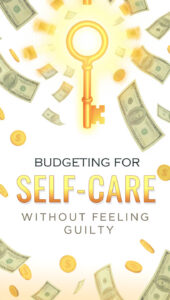Now Reading: Budgeting for Self-Care Without Feeling Guilty 💆♀️🌿💖
-
01
Budgeting for Self-Care Without Feeling Guilty 💆♀️🌿💖
Budgeting for Self-Care Without Feeling Guilty 💆♀️🌿💖
Because your well-being matters—even when money feels tight.
Let’s be real: as women, we’ve been conditioned to give, give, give—until we’re running on fumes.
And when it comes to spending money on ourselves, especially in a tight budget?
We hesitate. We overthink. We feel guilty.
But here’s the truth:
Self-care is not selfish. And budgeting for it isn’t a luxury—it’s a necessity.
If you’re trying to make every dollar stretch but still want space to breathe, to rest, and to feel human again—this is for you.
Let’s break down how you can prioritize self-care without sabotaging your budget—or your peace. 💗

💭 Step 1: Redefine What “Self-Care” Really Means
Spoiler alert: it’s not just spa days and $90 facials (though those are lovely too).
Real self-care is anything that helps you feel:
-
Nourished
-
Safe
-
Rested
-
Joyful
-
Whole
That might be:
-
A 15-minute walk alone with your favorite playlist
-
A $5 bubble bath that makes your Sunday feel sacred
-
Saying no to something that drains you
💡 Self-care isn’t always about money—it’s about intention.
But when your budget does allow room for it, let’s make that space wisely.
🧾 Step 2: Add a “Self-Care” Category to Your Budget (Yes, Really!)
If you want self-care to be part of your life, it needs to be part of your budget.
Start small. $10/week. $20/month. Whatever fits.
Label it “Me Fund” or “Peace Money” if that feels more empowering.
Here’s what this fund can cover:
-
A journal + fancy pen
-
A new book
-
A solo coffee shop date
-
A yoga class or digital membership
-
Hair care, skincare, or simply a comfy pair of pajamas 🧴💅
Even if it’s tiny, having this intentionally built in removes the guilt—and replaces it with joy.
🎯 Step 3: Plan Your Self-Care Like You Do Your Bills
This one’s key.
We don’t “wait and see” if we can pay rent, right?
We plan for it.
So why not plan for our well-being the same way?
At the start of each month:
-
Block off self-care time in your calendar
-
Choose what you want to use your budgeted amount for
-
Set one small emotional or physical goal (example: “I want to sleep better this month”)
📝 It doesn’t have to be expensive. It just has to be intentional.
🧘♀️ Step 4: Let Go of the Guilt (It’s Not Helping You Save)
Let’s talk about the emotional side of all this.
So many women feel shame for spending even small amounts on themselves—especially moms, caregivers, and those trying to get out of debt.
But here’s the reframe:
💬 When you care for yourself, you’re better equipped to care for everything else.
When you feel good, your energy shifts.
You budget better.
You make healthier choices.
You avoid impulse spending that comes from burnout or emotional fatigue.
That $12 journal might save you from a $100 stress-buying spree.
That $7 face mask might be the pause you need to avoid emotional exhaustion.
🧡 Real Talk: You Deserve to Be Cared For Too
You are not just a provider, a planner, or a doer.
You are a person—with needs, desires, and a soul that deserves softness.
Creating room in your budget for self-care isn’t irresponsible—it’s revolutionary.
And when you do it intentionally, within your means, and without guilt?
That’s when budgeting becomes more than just a tool—it becomes a gift.
you deserve self-care, no matter your budget.
Now let’s make that real.
This isn’t about treating yourself to luxury. It’s about showing up for yourself with love and intention, even if money is tight.
Here’s how to design a self-care routine that fits your life, your budget, and your season—without the guilt trip.
🌼 1. Self-Care Isn’t Always Spendy—Here’s the Proof
Not all self-care has to cost money. In fact, the most healing forms of care are often free or nearly free.
Here are ideas that cost little to nothing but feel deeply nourishing:
💖 Emotional Self-Care:
-
Journaling for 10 minutes each night
-
Saying “no” to things that drain you
-
A solo morning routine with no phone
🌿 Physical Self-Care:
-
Stretching to music
-
Walking barefoot in the grass
-
Taking a long, hot shower with candles lit
🎨 Creative Self-Care:
-
Doodling, painting, or crafting
-
Baking something from scratch
-
Rearranging your space for a fresh vibe
💡 The goal isn’t to spend money—it’s to fill your cup.
Money just helps when used mindfully.
📋 2. Create a Simple Self-Care Plan (That You’ll Actually Use)
No need to overcomplicate it. Start with a plan that’s as realistic as your current season.
Here’s a template you can steal:
🗓 Weekly Self-Care Mini Plan
-
💆♀️ One intentional rest activity (nap, slow walk, tech-free hour)
-
📖 One joy-sparking activity (reading, favorite show, art)
-
💸 One budgeted “treat” (under $10, something small but sweet)
Block these in your calendar. They’re appointments with yourself. You’re allowed to honor them.
✨ When your schedule reflects your needs, your energy transforms.
📊 3. Use a “Self-Care Tracker” in Notion or Journal
Tracking your self-care doesn’t make it rigid—it makes it visible.
Start simple. Create a weekly tracker with columns like:
-
“Did I rest?”
-
“Did I move my body?”
-
“Did I check in with my feelings?”
-
“Did I enjoy something just for me?”
💡 Add emojis, color coding, or stickers—make it fun, not another to-do list.
You’ll be amazed how simply seeing what fills you up helps you prioritize it better.
🤝 4. Get Your Partner/Family on Board (Without Guilt)
Sometimes, the hardest part isn’t money—it’s feeling like you need “permission” to care for yourself.
Here’s how to gently include your partner/family:
-
Communicate your need: “I’ve realized I’m feeling really drained lately, and I need some intentional time to refill my energy.”
-
Ask for a small window: Even 20 minutes to yourself on Sunday morning makes a difference.
-
Explain the benefit: “When I take care of myself, I show up better for everyone.”
💬 “I’m not stepping away from you—I’m stepping toward me, so I can show up stronger for us.”
You deserve support in your rest, not resistance.
🧠 5. Replace Guilt With Gratitude
Every time that guilty voice pops up—“I shouldn’t have spent that $12 on myself”—replace it with this thought:
💬 “I’m grateful I could do something kind for myself today. I’m worth it.”
Budgeting is not about deprivation.
It’s about alignment—spending less on what drains you, so you can spend more (money, time, energy) on what lifts you.
And when you choose self-care? You’re not being wasteful.
You’re being wise.
💌 Final Words: You Are Not “Extra”—You’re Essential
This season might be hard. The money might feel tight. But that doesn’t mean your needs stop mattering.
In fact, this is exactly when you need to pour into yourself most gently.
So build self-care into your budget—without apology.
Light the candle. Take the walk. Say the no.
You’re not asking for too much. You’re asking for what’s already yours.
💗 You are the heartbeat of your home. You deserve to be held too.














